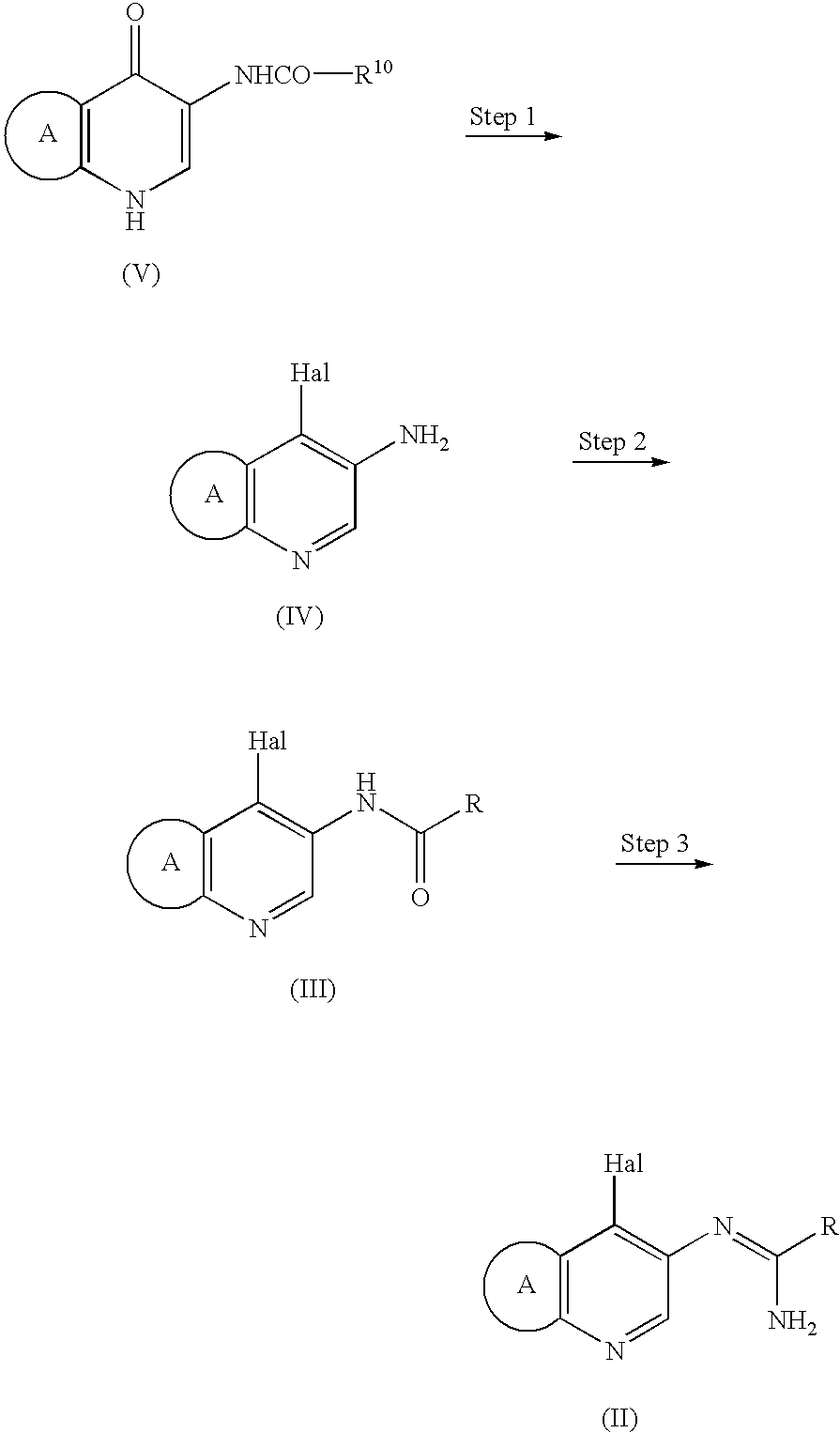Process for preparation of amidine derivatives
a technology of amidine derivatives and amidine, which is applied in the field of amidine derivatives production processes, can solve the problems of slowing down the reaction progress, difficult to evaporate dimethylformamide and remove it, and complicated procedures to remove impurities and isolate desired products
- Summary
- Abstract
- Description
- Claims
- Application Information
AI Technical Summary
Benefits of technology
Problems solved by technology
Method used
Image
Examples
example 1
Synthesis of Compound 3
[0071] 21
[0072] Compound 1 (30.0 g, 0.666 mol) was suspended in 165 mL of acetonitrile, and the suspension was cooled to -10.degree. C. 25.5 g of phosphorus oxychloride in dimethylformamide (40.5 g) was added dropwise to the suspension at -10.degree. C. to -5.degree. C. The mixture was heated to 45.+-.5.degree. C. over about 30 minutes and stirred for about 2 hours. After ice cooling, 180 mL of water was added dropwise to the mixture, the mixture was stirred to dissolve any precipitated material. After heating to 80.+-.5.degree. C., the mixture was stirred for about 1.5 hours with evaporating acetonitrile. The residue was concentrated under reduced pressure to about 15 mL of the volume and then cooled to room temperature. The residue was washed with 150 mL of toluene (or ethyl acetate), and the washing solution was extracted with 30 mL to 60 mL of water. To the obtained aqueous layer, 48% sodium hydroxide aqueous solution was added until pH 4-6, and seed cryst...
example 2
Synthesis of Compound 4
[0074] 22
[0075] Compound 3 (24.0 g) and 16.17 g of isoxazole-3-carboxylic acid were suspended in 288 mL of acetone, 49.36 g of pyridine was added thereto and the suspension was cooled to -10.degree. C. 31.89 g of phosphorus oxychloride was poured into the suspension to react at 20.+-.10.degree. C. for about 30 minutes. The reaction mixture was cooled to 5.degree. C. or below, 5.3 mL of water was added dropwise to the mixture at 20.degree. C., and 355 mL of water was poured therein. Then, 10% sodium hydroxide aqueous solution was added dropwise to the mixture until pH 4.5, and the mixture was stirred at 15.+-.10.degree. C. for about 2 hours to precipitate crystals. The crystallized slurry obtained was filtered, and the crystals were washed sequentially with 48 mL of 10% aqueous acetone, 192 mL of water, and 72 mL of 10% aqueous acetone, and dried in vacuo to afford Compound 4 (33.24 g, 91.4%).
example 3
Synthesis of Compound 6
[0076] 23
[0077] Compound 4 (10.0 g) was suspended in 100 mL of acetonitrile, and the suspension was cooled to 5.degree. C. 10.4 g of phosphorus oxychloride was added to this suspension to react at room temperature for about 1 hour. 3.96 g of pyridine was then poured into the reaction mixture, which is then heated to 45.+-.5.degree. C. to react for about 3 hours. The reaction mixture was cooled to 20.degree. C. and poured into 15% brine (80 g) which was previously cooled to -10.degree. C. After the layers were separated, 100 mL of acetonitrile was added to the aqueous layer, the pH was adjusted to 3 with 10% sodium hydroxide aqueous solution, and the acetonitrile layer was separated. After the acetonitrile layers were combined and the reaction apparatus were washed with 10 mL of acetonitrile to collect residual reactants, 28% aqueous ammonia was added to the mixture to react at 30.+-.5.degree. C. for about 3 hours. The reaction mixture was concentrated to 80 mL...
PUM
| Property | Measurement | Unit |
|---|---|---|
| boiling point | aaaaa | aaaaa |
| temperature | aaaaa | aaaaa |
| temperature | aaaaa | aaaaa |
Abstract
Description
Claims
Application Information
 Login to View More
Login to View More - R&D
- Intellectual Property
- Life Sciences
- Materials
- Tech Scout
- Unparalleled Data Quality
- Higher Quality Content
- 60% Fewer Hallucinations
Browse by: Latest US Patents, China's latest patents, Technical Efficacy Thesaurus, Application Domain, Technology Topic, Popular Technical Reports.
© 2025 PatSnap. All rights reserved.Legal|Privacy policy|Modern Slavery Act Transparency Statement|Sitemap|About US| Contact US: help@patsnap.com



